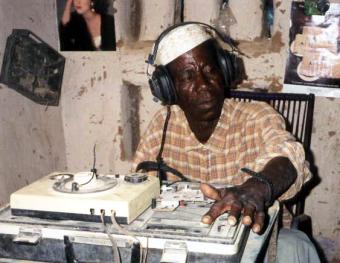 |
LA VIE SUR TERRE
Das Leben auf
Erden
Life on Earth
Abderrahmane
Sissako
Mali/Frankreich
1998
Produktion: Haut et
Court, La Sept/Arte
Weltvertrieb: Celluloid Dreams 24, rue Lamartine, 75009 Paris
Tel. (33-1) 49 70 03 70, Fax 49 70 03 71
Buch:
Abderrahmane Sissako
Kamera: Jacques Besse
Ton: Pascal Amant
Schnitt: Nadia Ben Rachid
Mischung: William Flageollet
Mitwirkende: Abderrahmane Sissako, Nana Baby, Mohamed Sissako, Bourama
Coulibaly, Keita Bina Gaoussou
Sprache: Bambara, Französisch
Format:
35mm, 1:1.66, Farbe Länge: 61 Minuten, 24 B/sek.
|
| Der
aus Mauretanien stammende Regisseur Abderrahmane Sissako fährt von
Paris nach Mali, um im Dorf seines Vaters die Jahrtausendwende zu erleben.
Er steigt auf ein Fahrrad, streift durch die Gassen, über die Felder
und Plätze des Dorfes, trifft dabei auf Nana, eine junge Frau, die
wie er nur zu Besuch ist. Halb dokumentarisch, halb fiktiv schildert der
Film das Dorfleben, dessen Alltag das Jahrtausendereignis kaum berührt,
und reflektiert – aus dem Off formuliert und durch Zitate von Aimé
Césaire angereichert – die komplizierte Beziehung zwischen
Europa und Afrika. “Auf einen Schlag werden wir nach Sokolo versetzt,
in ein kleines Dorf in Mali, in eine afrikanische Welt, von der man auf
einen Blick weiß, daß sich fast niemand mehr für sie
interessiert. Eine Herausforderung für Sissako, den einsamen Botschafter
eines Kontinents, dessen Stimme und Bilder immer mehr verlöschen.
Sissako rettete sich, stolz und entschieden, indem er einen Film auf seine
Art machte: als Hommage an die Seinen, in der er von der Rückkehr
ins Land seiner Kindheit erzählt, mit Respekt für die anderen,
uns andere, denen er den beklagenswerten Zustand der Welt beschreibt,
um sie schließlich mit einem ermutigenden Minnegesang zu preisen.
Deshalb lautet die verborgene Philosophie dieses nachdenklichen Films:
Das Beständige wird immer über den Lauf der Zeit siegen.”
Gérard Lefort |
Mauretanian born filmmaker
Abderrahmane Sissako travels from Paris to Mali to spend time in his
father’s village during the transition to the new millenium. He
gets on a bicycle, walks through the streets, crossing the fields and
the village squares. During his exploits he meets Nana, a young woman
who is also only here on a visit. Part documentary and part fiction,
the film describes village life that is hardly touched by the arrival
of the new millenium. It reflects the complicated relationship between
Europe and Africa, using off-screen commentary and quotes by Aimé
Césaire. “Life on Earth which was made for the Arte series
Collection 2000 is just simply a lively film. ‘Simply’ connotes
the following: the film is full of work, doubts and consequently it
is full of fantastic moments, light heartedness and poetry. In a flash,
we find ourselves in Sokolo, a small village in Mali, an African world
no longer the focus of anyone’s interest. It is a challenge for
Sissako, lonely ambassador of a continent whose voice and images are
increasingly fading away. Proud and determined, Sissako saved himself
by making the film his own way: as an homage to his people in which
he tells us about his return to the land of his childhood. Showing respect�
for the others, for us, he describes the present condition of the world
(very bad), finally praising it with an encouraging love song. This
thoughtful film has a message: continuity will always outlast the passage
of time. “ Gérard Lefort
|
Biofilmographie
/ Biofilmography
Abderrahmane Sissako wurde am 13. Oktober 1961 in Kiffa/Mauretanien
geboren. Er verbrachte seine Kindheit in Mali, studierte an der Filmhochschule
Moskau und ließ sich anschließend in Paris nieder. Sein erster längerer
Film, der Dokumentarfilm Rostov-Luanda, war auch auf der Kasseler Documenta
1997 zu sehen.
Abderrahmane Sissako was born October 13th, 1961 in Kiffa/Mauritania.
He spent his childhood in Mali, attended film school in Moscow at the
WGIK, then settled in Paris. His first long film, the documentary Rostov-Luanda,
was seen during the 'Documenta' in Kassel in 1997.
Films/Filme
1989: Le jeu (26 minutes). 1993: Octobre (37 minutes). 1994: Molom, Conte
de Mongolie (artistic direction/künstlerische Leitung). 1995: Le
chameau et les batons flottants (6 minutes) 1996: Sabriya (26 minutes).
1997: Rostov-Luanda (60 minutes). 1998: LA VIE SUR TERRE. |